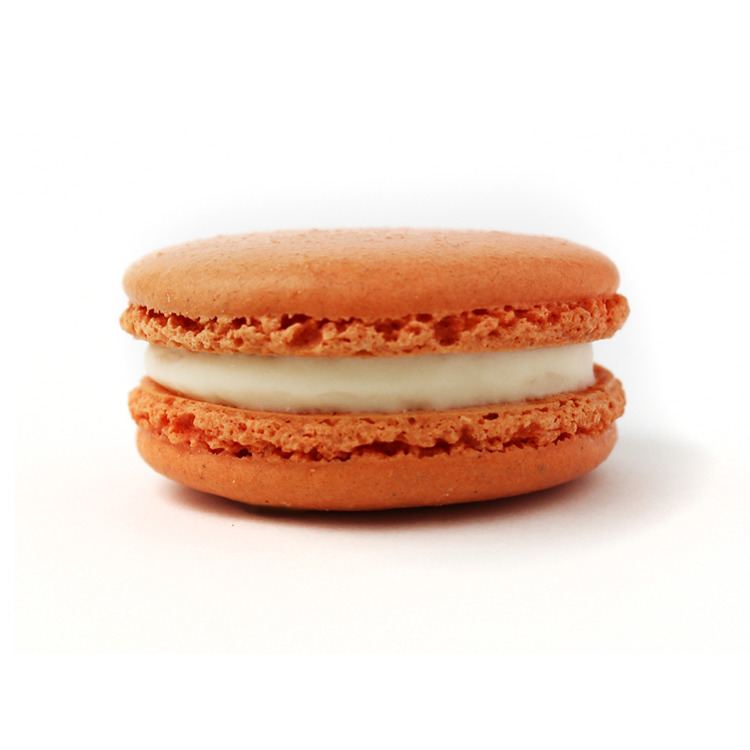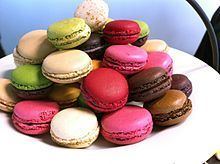Place of origin France | Course Entrepreneur | |
 | ||
Created by The chef of Catherine de' Medici in Italy Main ingredients Cookie: Egg white, icing sugar, granulated sugar, almond powder or ground almond, food coloringFilling: buttercream, ganache, or jam Similar Meringue, Macaroni, Ganache, Pastry, Cupcake | ||
The science behind french macarons kitchen conundrums with thomas joseph
A macaron (/ˌmɑːkəˈrɒn/ mah-kə-ROHN; [makaʁɔ̃]) is a sweet meringue-based confection made with egg white, icing sugar, granulated sugar, almond powder or ground almond, and food colouring. The macaron commonly consists of a ganache, buttercream or jam filling sandwiched between two cookies. The name is derived from the Italian word macarone, maccarone or maccherone, the meringue.
Contents
- The science behind french macarons kitchen conundrums with thomas joseph
- Raspberry lemon macaron bruno albouze the real deal
- History
- Earliest recipe
- Method
- American variations
- French regional variations
- Switzerland
- Korea
- Japan
- Popularity
- References
The confection is characterized by a smooth squared top, a ruffled circumference (referred to as the "foot" or "pied"), and a flat base. It is mildly moist and easily melts in the mouth. Macarons can be found in a wide variety of flavors that range from the traditional (raspberry, chocolate) to the new (foie gras, matcha). They are often said to be difficult to make.

The related macaroon is often confused with the macaron. In English, most bakers have adopted the French spelling of macaron for the meringue-based item, to distinguish the two. This has caused confusion over the correct spelling. Some recipes exclude the use of macaroon to refer to this French confection while others treat the two as synonymous. The two food items are different, and the terms in English distinguish them. Etymologically, the word macaroon is simply an Anglicisation of the French word macaron (compare balloon, from French ballon). Multiple pronunciations are technically correct depending on personal preference and context. In a Slate article on the topic, Stanford professor of linguistics and computer science Dan Jurafsky indicates that "macaron" (also, "macaron parisien", or "le macaron Gerbet") is the correct spelling for the confection.
Raspberry lemon macaron bruno albouze the real deal
History
Macarons have been produced in the Venetian monasteries since the 8th century A.D. During the Renaissance, Catherine de' Medici's Italian pastry chefs made them when she brought them with her to France in 1533 upon marrying Henry II of France. Larousse Gastronomique cites the macaron was created in 1791 in a convent near Cormery. In 1792, macarons began to gain fame when two Carmelite nuns, seeking asylum in Nancy during the French Revolution, baked and sold the macaron cookies in order to pay for their housing. These nuns became known as the "Macaron Sisters". In these early stages, macarons were served without special flavors or fillings.
It was not until the 1830s that macarons began to be served two-by-two with the addition of jams, liqueurs, and spices. The macaron as it is known today, composed of two almond meringue discs filled with a layer of buttercream, jam, or ganache filling, was originally called the "Gerbet" or the "Paris macaron." Pierre Desfontaines of the French pâtisserie Ladurée has sometimes been credited with its creation in the early part of the 20th century, but another baker, Claude Gerbet, also claims to have invented it. French macaron bakeries became trendy in North America in the 2010s.
Earliest recipe
Many Italian cookbooks of the 16th century mention almond biscuits closely resembling macarons albeit under different names. The earliest known recipe dated back from the early 17th century and appears to be inspired by a French version of the recipe.
Method
There are two methods to making a macaron - the "French" method and the "Italian" method. The difference between the two is the way the meringue is made - either Italian or French meringue can be combined with ground almonds.
A macaron is made by combining icing sugar and ground almonds until fine. In a separate bowl, egg whites that are beaten until a meringue-like texture. The two elements are then folded together until they are the consistency of "shaving foam", and then are piped, left to form a skin, and baked. Sometimes, a filling is added.
American variations
Flavors of macarons available in America are available in respect to the general tastes of the public. These include flavors such as mint chocolate chip, peanut butter and jelly, snickers, peach champagne, pistachio, strawberry cheesecake, candy corn, salted pretzel, chocolate peanut butter, oatmeal raisin, candy cane, cinnamon, maple bacon, pumpkin, and salted caramel popcorn.
French regional variations
Several French cities and regions claim long histories and variations, notably Lorraine (Nancy and Boulay), Basque Country (Saint-Jean-de-Luz), Saint-Emilion, Amiens, Montmorillon, Le Dorat, Sault, Chartres, Cormery Joyeuse and Sainte-Croix in Burgundy.
Macarons d'Amiens, made in Amiens, are small, round-shaped biscuit-type macarons made from almond paste, fruit and honey, which were first recorded in 1855.
The city of Montmorillon is well known for its macarons and has a museum dedicated to it. The Maison Rannou-Métivier is the oldest macaron bakery in Montmorillon, dating back to 1920. The traditional recipe for Montmorillon macarons remains unchanged for over 150 years.
The town of Nancy in the Lorraine region has a storied history with the macaron. It is said that the abbess of Remiremont founded an order of nuns called the "Dames du Saint-Sacrement" with strict dietary rules prohibiting the consumption of meat. Two nuns, Sisters Marguerite and Marie-Elisabeth are credited with creating the Nancy macaron to fit their dietary requirements. They became known as the 'Macaron Sisters' (Les Soeurs Macarons). In 1952, the city of Nancy honored them by giving their name to the Rue de la Hache, where the macaron was invented.
Switzerland
In Switzerland the Luxemburgerli (also Luxembourger) is a brand name of confectionery made by the Confiserie Sprüngli in Zürich, Switzerland. A Luxemburgerli is a macaron comprising two disks of almond meringue with a buttercream filling. Luxemburgerli are smaller and lighter than macarons from many other vendors. It is said to be lighter and more airy in consistency. Flavors include: vanilla, chocolate, stracciatella (chocolate chip), caramel, hazelnut, champagne, amaretto, chestnut, mocha, cinnamon, lemon, mandarin, and raspberry. Many flavors are seasonal. The shelf life is three to five days, refrigerated.
Luxemburgerli were invented by the confectioner Camille Studer who brought the recipe to Zürich after creating them in a Luxembourg confectionery shop (Confiserie Namur) in 1957. There, the recipe was refined for a confectionery contest. The name Luxemburgerli is derived from the nickname which a colleague bestowed on Studer, whose family originated in Luxembourg. The original name, Baiser de Mousse (foam kiss in French), perceived as appropriate for the new creation, was changed to Gebäck des Luxemburgers ("Luxemburger's confection") which became, in Swiss German, Luxemburgerli ("little Luxembourger").
Korea
Macarons are popular in South Korea, pronounced as "ma-ka-rong" in Korean. Green tea powder or leaves can be used to make green tea macarons.
Japan
Macarons in Japan are a popular confection known as "makaron". There is also a version of the same name which substitutes peanut flour for almond and is flavored in wagashi style, widely available in Japan. The "makaron" is featured in Japanese fashion through cell phone accessories, stickers, and cosmetics aimed towards women.
Popularity
In Paris, the Ladurée chain of pastry shops has been known for its macarons for about 150 years. In France, McDonald's sells macarons in their McCafés (sometimes using advertising that likens the shape of a macaron to that of a hamburger). McCafé macarons are produced by Château Blanc, which, like Ladurée, is a subsidiary of Groupe Holder, though they do not use the same macaron recipe.
Outside of Europe, the French-style macaron can be found in Canada and the United States.
In Australia, Adriano Zumbo along with the TV series MasterChef have seen the macaron become a popular sweet treat, and it is now sold by McDonald's in its McCafe outlets.
On a global level, March 20 celebrates "Macaron Day". Created in 2005 in Paris by la Maison Pierre Hermé, it is a tradition that spread across the world. On this day, participating bakeries and macaron shops around the world offer customers one free sample macaron. A percentage of all additional macaron sales is donated to a local charity.
In Korea, the macaron has been a 'trend'. The treat became so popular, that some companies started delivery services for macarons. Macarons have become a popular gift in Korea between friends and lovers, as a symbol of affection. Moreover, famous hotels (Lotte Department) and buffets (Ashely) began to provide mountainous stacks of macarons as a way of attracting more guests into their business.
